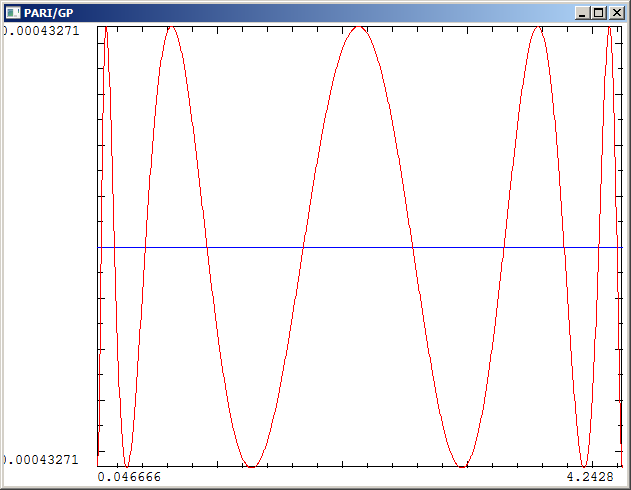(I asked this in MSE but did not find resonance, there is also a relation to an older discussion here on summability see here and a followup formulating an $\text{ais}()$ already here)
Motivation
I'm considering functions, represented by Carleman matrices of infinite size, for instance $f(x)=t^x - 1$.
Let us denote the iterates of $f(x)$ by indexes on $x$ like $x_0=x$, $x_1=f(x)$, $x_2 = f(f(x))$ and also $x_{-1} = \log_t(1+x)$ and so on. For $t$ in the interval $1 < t < e$ and $x_0$ in an interval from zero to some small limiting value we have convergence for $x_{n}$ and $x_{-n}$ for $n \to \infty$.
Then I look at the infinite alternating series (" ais ": "alternating iteration series") $$ \text{ais}(x)= \cdots \pm x_{-k} \cdots - x_{-3} + x_{-2} - x_{-1} + x_0 - x_1 + x_2 - x_3 \cdots \pm x_k \cdots \tag 1$$ and for practical reasons (numerical computations using Pari/GP and its "sumalt()"-function) I define $$ \begin{array} {rl} \text{ais}_n(x_0)&= x_0 - x_{-1} + x_{-2} - x_{-3} + \cdots \pm x_{k} \cdots \\ \text{ais}_p(x_0)&= x_0 - x_1 + x_2 - x_3 + \cdots \pm x_k \cdots \\ \text{ais}(x_0) &= \text{ais}_n(x_0) + \text{ais}_p(x_0) - x_0 \end{array} \tag 2$$ Because $x_{-n}$ converge to a nonzero value one can also use Cesaro- or Euler-summation for the alternating series $\text{ais}_n(x)$ .
The matrix-ansatz...
To save computation time I thought I can make use of the Neumann-series of the Carleman-matrices $T$ for $f(x)=t^x-1$ and $T^{-1}$ for $f°^{-1}(x)=\log(1+x)/\log(t) $ such that with a vector $V(x)=[1,x,x^2,x^3,...]$ I can write
$$ V(x) \cdot T = V(t^x-1) \\
V(x) \cdot T^{-1} = V(\log_t(1+x)) \tag 3 $$
and using the Neumann-series make a shortcut to
$$ V(x_0) \cdot ( I - T + T^2 - T^3 + \cdots - \cdots )=V(x_0) - V(x_1)+ V(x_2) - \cdots + \cdots $$
(All this is computationally simple to check and to manually approximate because $T$ and $T^{-1}$ are triangular and have also the Carleman-structure.)
So using $A_p = (I + T)^{-1}$ and its second column only I get, as expected (...drumroll...) $$ V(x_0) \cdot A_p[,1] = \text{ais}_p(x_0) \tag 4$$
...and the conceptional problem
However, this is not so with the supposed Neumann-series of its inverse $A_n = (I + T^{-1})^{-1}$. Here I get , with some error-term $d(x_0)$,
$$ V(x_0) \cdot A_n[,1] = \text{ais}_n(x_0) + d(x_0) \tag 5$$
Unfortunately the analogy to the geometric series of scalars breaks here: for the geometric series of a scalar argument we can analytically continue $$ a_p(x) = 1-x+x^2-x^3 + \cdots - \cdots = { 1 \over 1 + x} \\ a_n(x)=1-x^{-1}+x^{-2}-x^{-3} + \cdots - \cdots = { 1 \over 1 + x^{-1}} \\ a_p(x) + a_n(x) - x^0 = 0 \tag 6$$ for any $x \ne \{-1,0\}$
Now the Neumann-series is not defined if the powers of $T^{-1}$ are not converging. However, because the occuring deviation $d(x_0)$ looks small and somehow systematic (much sinusoidal) I hope there might be some correction-factor
to make sense to the general ansatz $ A_n = (I + T^{-1})^{-1}$. Perhaps something like the integral-term for the Ramanujan-summation or some extension to the matrix $A_n$.
I've searched for articles on the Neumann-series, but didn't find any which deals with the divergent case. So my question:
Q: is something known whether there is some systematic correction-factor for the correction $d(x_0)$ in the case where the Neumann-series diverges? The Neumann-series for $T^{-1}$ does not converge for this class of examples.
Remark: I have already a solution which allows to compute correctly $\text{ais}(x)$ with the Carleman-matrix-method: using two different such matrices. Here I'm asking specifically for some analytical access to the problem of divergence in the Neumann-series.
Update: A plot of $d(x)$ for $x=\{x_{-5} \ldots x_5\}$ for some base $t$ which I use for numerical tests shows nearly perfect sinusoidal behave with pseudo-period $2h$ where $h$ is the iteration-height. Of course the heights $h$ are not linear with the $x$ coordinate, so we see that decreasing wavelength at the right and left border. That frappant sinusoidal behave inspired my hope that the correction-factor $d(x)$ might be analytically expressible at all:

*(Pari/GP)* ploth(x=itx(x0,5),itx(x0,-5),maisx(x,5))
*%1052 = [0.0466657282692, 4.24284898742, -0.000432707353441, 0.000432710734738]*
